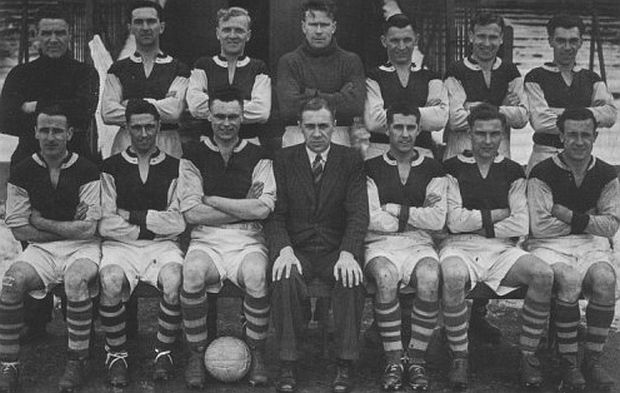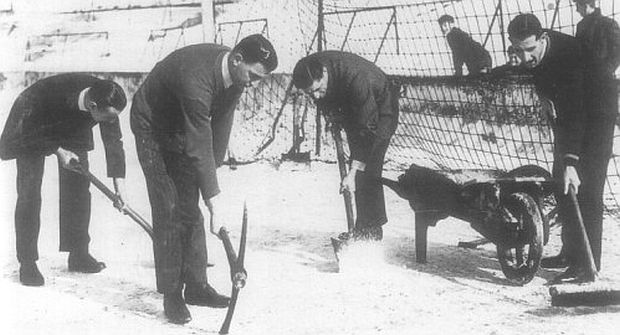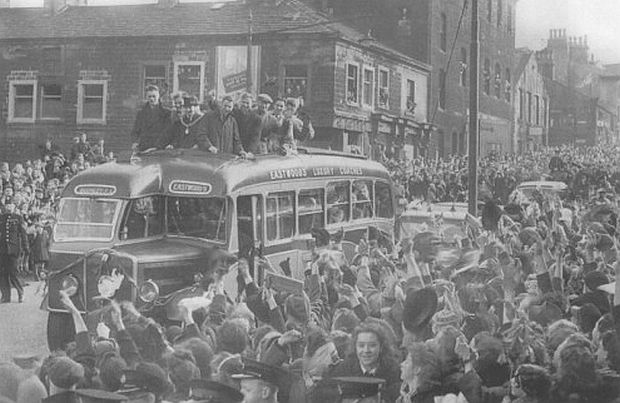As the country adapted to peacetime once again in 1945 so Burnley Football Club awaited a return to league action. Regional war time football had continued during the war years and would do so for one more season although there was a return for the FA Cup. In a two legged affair we went out at the first time of asking to Stoke with Derby going on to beat Charlton in the final and become the first post-war winners.
At Burnley we’d been without a manager for much of the war period so one of the first tasks was to appoint a new boss as we looked to try and get ourselves out of the Second Division, where we'd been since suffering relegation in the 1929/30 season. The man chosen was former Everton and England player Cliff Britton who had built up a reputation in the 1930s as one of the best passes of a ball in the game.
 |
| The 1946/47 team which won promotion and reached the FA Cup Final |
The new manager immediately submitted a three year plan to the board of directors, aiming for that much sought after promotion by the end of the 1948/49 season to ensure we would enter the 1950s in the First Division. The plan came unstuck somewhat as we made a triumphant return two years earlier than the plan had suggested.
When the league resumed in the 1946/47 season it did so with the same fixtures that had been set for the aborted 1939/40 season, and so, once again, we kicked off with a home game against Coventry.
The war had taken away the careers of many players, and when we lined up for the first game it was a very much different Burnley team than had last played in a league game at Birmingham, two days short of seven years earlier. Only Arthur Woodruff and George Bray remained from that pre-war team in Britton’s first line up.
It was to be a long season as one of the worst winters on record set in and it was a full week into June before it came to an end, but it was a season that ended with a first ever visit to Wembley as well as a second place finish and promotion two years ahead of the plan.
Over 18,000 saw the first home game of the season but attendances improved and when we took the field for our last home game against Bury there were over 40,000 inside Turf Moor to see us draw 1-1 and leave us just needing a point to clinch second place and promotion. That was achieved in the next game as we won 5-0 at West Ham with two of the goals scored by a young player who had arrived at Turf Moor in the late 1930s, a certain Harry Potts.
That win came just a month after we’d gone down to Charlton in the FA Cup Final with a goal in the last minute of extra time. We were so close to our second FA Cup win and also to an incredible double. Over 450,000 watched us during the cup run that saw wins against Aston Villa, Coventry, Luton, Middlesbrough and Liverpool before the defeat to Charlton.
 |
| The Burnley players help prepare the snowbound Turf Moor pitch for the Middlesbrough cup replay |
Almost 50,000 were there for a Tuesday afternoon replay against Middlesbrough in the 6th round which was won 1-0 and that took us to two full houses in the semi-final and its replay against Liverpool. The first of those was played at Ewood Park, not something you would expect now should we ever get that far in the competition. It ended all square before the replay win at Maine Road took us to Wembley. The winning goal in the final, scored by Charlton's Chris Duffy, was only the third we had conceded in the entire cup run.
This was a new look Burnley, with so many new names in the side who were set to go on and establish the club for great times ahead. From Jimmy Strong in goal, full back Harold Mather joining Woodruff and a half back line of Reg Attwell, Alan Brown and Bray that was begining to be talked about in the same way as Halley, Boyle and Watson had thirty years earlier.
It was a team that conceded so few goals that it became known as the Iron Curtain defence but there were some top forwards too with wingers Jackie Chew and Peter Kippax, centre forwards Jack Billingham and Ray Harrison alongside inside forwards Billy Morris and Potts. Football was back and Burnley were back in the big league.
Although Cliff Britton’s three year plan was two years ahead of schedule, he was going to waste no time in ensuring we established ourselves back in Division One. A season of consolidation would have been fine for most supporters but it was to be far better than that as we challenged at the top of the league all season.
The crowds were flocking into Turf Moor and the 52,869 who watched the game against Blackpool in October 1947 remains the record for a league game at Burnley. We didn’t disappoint the big crowd either and won the game 1-0 with schemer Potts again on the scoresheet.
There had been little change to the promotion team although Harrison and Kippax were playing less and less as we ended the season in 3rd place, seven points behind champions Arsenal and behind Manchester United, who were second, only on goal average.
 |
| Burnley supporters turn out in their thousands as the team returns from Wembley in 1947 |
Life as a Burnley supporter in the post war period was an exciting one but after those two superb seasons there were to be changes. Firstly, inspirational captain Alan Brown left early in the 1948/49 season to join Notts County and shortly afterwards it was manager Cliff Britton who departed after being lured back to Everton.
Just before his departure Britton, who was keen on enhancing youth football, signed two young players from the North East of England. Their names were Tommy Cummings and Jimmy Adamson. Our first post war manager had left a legacy.
The directors turned to Crewe for his replacement and duly appointed their manager Frank Hill, a top player in his time who had played wing half in the all conquering Arsenal side of the 1930s.
Although we never reached the heights of the previous season we were never in any relegation danger and ended the season in 15th place. It had been a season of change and by the end of it, one of those two youngsters Cummings had established himself as the regular centre half.
As the decade came to an end Burnley were very much a top division side and the 1949/50 season saw us back in the top half of the league, albeit just about with a tenth place finish. It was still boom time in terms of attendances and new players were being blooded, notably Les Shannon and Roy Stephenson.
Manager Hill was also building for the future and he cast his net far and wide for new talent. Just after the New Year in 1950 reports came through of an outstanding teenager playing his football for Glentoran in the Irish League. The manager himself made the journey to Belfast to watch him. He was so suitably impressed that within no time we had signed him. That young Irishman Jimmy McIlroy was a Burnley player.
The 1940s had been for much of the time a depressing decade with wars being fought in Europe and beyond but it ended for those in Burnley who had an interest in football with real promise for the future.
